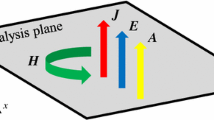Abstract
In this paper, an equivalent circuit model for magnetoelastic resonator is introduced. Elements of the model consist of coil inductance, magnetization of the resonator, a parallel RLC resonator representing the resonator resonance and a transformer indicating conversion ratio. This model suggests an approach to describe electrical response and characteristics of the resonator subject to geometries and excitation conditions. Moreover, corresponding techniques for extraction of parameters of the system are developed. Experimental results show that the model gives reasonable approximation of the system and accurately predicts behavior of the system.
Similar content being viewed by others
References
A. Bund and G. Schwitzgebel, Viscoelastic properties of low-viscosity liquids studied with thickness-shear mode resonators, Analytical chemistry, 70 (13) (1998) 2584–2548.
P. G. Stoyanov and C. A. Grimes, A remote query magnetostrictive viscosity sensor, Sensors and actuators A, Physical, 80 (1) (2000) 8–14.
K. Zeng, Wireless magnetoelastic physical, chemical, and biological sensors, IEEE Transactions on Magnetics, 43 (6) (2007) 2358–2363.
R. Jahns, H. Greve and E. Woltermann, Sensitivity enhancement of magnetoelectric sensors through frequencyconversion, Sensors and Actuators A, Physical, 183 (2012) 16–21.
B. D. Pereles, T. Dienhart, T. Sansom, K. Johnston and K. G. Ong, A wireless, passive load cell based on magnetoelastic resonance, Smart Materials & Structures, 21 (7) (2012).
K. G. Ong, C. A. Grimes, C. L. Robbins and R. S. Singh, Design and application of a wireless, passive, resonantcircuit environmental monitoring sensor, Sensors and Actuators A, Physical, 93 (1) (2001) 33–43.
Y. Le Bras, A. Lasheras, J. Gutierrez, F. Mazaleyrat and J. M. Greneche, A new magneto-elastic resonance based technique to determine magneto-mechanical parameters of amorphous ferromagnetic ribbons, The Review of Scientific Instruments, 84 (4) (2013).
C. Xue, X. Li and C. Yang, Modeling and design of magnetoelastic micro-resonator system for ultrasensitive mass sensing applications, IEEE Transactions on Magnetics, 48 (11) (2012) 4092–4095.
K. G. Ong, M. Paulose and C. A. Grimes, A wireless, passive, magnetically-soft harmonic sensor for monitoring sodium hypochlorite concentrations in water, Sensors, 3 (1) (2012) 11–18.
Du Trâemolet de Lacheisserie E, Magnetostriction: Theory and applications of magnetoelasticity, CRC Press, Boca Raton, FL (1993).
L. Wang and F. G. Yuan, Vibration energy harvesting by magnetostrictive material, Smart Materials & Structures, 17 (4) (2008) 045009.
M. Dapino, R. Smith and A. Flatau, Structural magnetic strain model for magnetostrictive transducers, IEEE Transactions on Magnetics, 36 (3) (2000) 545–556.
M. Schönbächler, Thermodynamic correlation tests between magnetostrictive and magnetomechanical effects in 2% Mn pipeline steel, IEEE Transactions on Magnetics, 24 (5) (1988) 2177–2180.
B. D. Cullity and C. D. Graham, Introduction to magnetic materials, 2nd ed., John Wiley & Sons, Inc. Hoboken, NJ, USA (2008).
F. Firestone, The mobility method of computing the vibration of linear mechanical and acoustical systems: Mechanical-electrical analogies, Journal of Applied Physics (1938).
P. E. Wellstead, Introduction to physical system modelling, Academic Press, London, UK (1979).
M. Dapino, R. Smith, F. Calkins and A. Flatau, A magnetoelastic model for Villari-effect magnetostrictive sensors, DTIC Document (2002) 1–17.
R. L. Boylestad and L. Nashelsky, Electronic devices and circuit theory, 9th ed., Prentice Hall, Upper Saddle River, NJ, USA (2008).
T. O’Dell, Measurement of magnetomechanical coupling factor in amorphous ribbons, Physica Status Solidi (a), 565 (1982) 565–572.
S. Schmidt and C. A. Grimes, Characterization of nanodimensional thin-film elastic moduli using magnetoelastic sensors, Sensors and Actuators A: Physical, 94 (3) (2001) 189–196.
C. Mungle, C. A. Grimes and W. R. Dreschel, Magnetic field tuning of the frequency-temperature response of a magnetoelastic sensor, Sensors and actuators A, Physical, 101 (2002) 143–149.
Author information
Authors and Affiliations
Corresponding author
Additional information
Recommended by Associate Editor Gil Ho Yoon
Y. S. Choi was born in Daegu, South Korea, on 7 February 1983. He received Ph.D. degree in Mechanical Engineering from Seoul National University, Seoul, South Korea, 2015. During a stay at the Seoul National University in 2006–2015, he did research work on telemetry systems and magnetostrictive sensors.
J. W. Yoo was born in Seoul, South Korea, on 6 June 1985. He received M.S. degree in Mechanical Engineering from Seoul National University, Seoul, South Korea, 2014. His research interests are ultrasonic and magnetostrictive system, basically based on resonant principles.
S. J. Kang was born in Mokpo, South Korea, on 10 February 1989. He received M.S. degree in Mechanical Engineering from Seoul National Univerity. His research interests are embedded systems and ultrasonics.
S. K. Kauh received Ph.D. degree in Mechanical Engineering from Seoul National University, Seoul, South Korea, 1987. Since 1989, he has been on the faculty of the Department of Mechanical Engineering at Seoul National University. His research interests include embedded systems, telemetry and precision instrumentation systems.
Rights and permissions
About this article
Cite this article
Choi, Y.S., Yoo, J.W. & Kauh, S.K. Modeling of magnetoelastic resonator using h-parameter analysis. J Mech Sci Technol 30, 749–761 (2016). https://doi.org/10.1007/s12206-016-0130-9
Received:
Revised:
Accepted:
Published:
Issue Date:
DOI: https://doi.org/10.1007/s12206-016-0130-9




